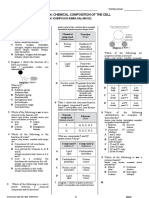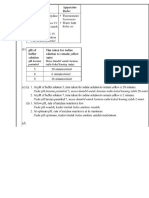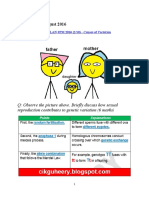0 ratings0% found this document useful (0 votes)
72 viewsBio 2012 Jawapan
Bio 2012 Jawapan
Uploaded by
Ismaliza IshakSPM 2012
Copyright:
© All Rights Reserved
Available Formats
Download as DOCX, PDF or read online from Scribd
Bio 2012 Jawapan
Bio 2012 Jawapan
Uploaded by
Ismaliza Ishak0 ratings0% found this document useful (0 votes)
72 views4 pagesSPM 2012
Copyright
© © All Rights Reserved
Available Formats
DOCX, PDF or read online from Scribd
Share this document
Did you find this document useful?
Is this content inappropriate?
SPM 2012
Copyright:
© All Rights Reserved
Available Formats
Download as DOCX, PDF or read online from Scribd
Download as docx or pdf
0 ratings0% found this document useful (0 votes)
72 views4 pagesBio 2012 Jawapan
Bio 2012 Jawapan
Uploaded by
Ismaliza IshakSPM 2012
Copyright:
© All Rights Reserved
Available Formats
Download as DOCX, PDF or read online from Scribd
Download as docx or pdf
You are on page 1of 4
fa) Cashew nut/Kacang gajus = 95°C
Dried bread/Roti kering = 45°C
Dried fish’Ikan kering = 50°C
(b) (i) 1. The final temperature of the distiled water when the cashew nut is bumt completely is 95°C.
Suhu akhir air suling apabila kacang gajus terbakar sepenuhnya ialah 95°C.
2. The final temperature of the distilled water when the dried bread is bumt completely is 45°C
Suhu akhir air suling apabila roti kering terbakar sepenuhnya ialah 45°C.
(i) 1, Water absorbs heat energy fiom the buming food. The buming of cashew nut releases more heat
fenergy.
Air menyerap tenaga haba daripada makanan yang dibakar. Pembakaran kacang gajus
membebaskan banyak tenaga haba.
2. The buming of dried bread releases less heat energy
Pembakaran roti kering membebaskan kurang tenaga haba.
(c)
Variable Method to handle the variable
Pembolehubah Cara mengendali pembolehubah
‘Manipulated variable: The Carry out the experiment by using different food samples
type of food sample Menjalankan eksperimen dengan menggunakan sampel makanan berbeza
Pembolehubah dimanipulasikan:
Jenis sampel makanan
Responding variable: The final | Record the final temperature of the distilled water by using a
temperature of the distilled thermometer. Calculate the energy value by using the following
water, the energy value formula:
Variable Method to handle the variable
Pembolehubah Cara mengendali pembolehubah
Pembolehubah bergerak balas: Mass of water x 4.2 Jg“' °C! x temperature increase
Sub akhir air suling, nila Mass of food
tenaga Merekod sul akhir air suling dengan menggunakan termometer. Hitung
nilai tenaga dengan menggunakan formula berikut:
Jisim air x 4.2 3g °C" x kenaikan suhu
Jisim makanan
Constant variable: The mass | Fix the mass of the food at 2 ¢
of the food sample Tetapkan jisim: makanan iaitu 2 g
Pembolehubah dimalarkan: Jisim
sampel makanan
(d) The cashew nut has a highest final increase in temperature of the distiled water.
Kacang gajus mempunyai kenaikan suhu akhir air suling yang paling tinggi.
e)
Food | Increase in water | Energy
sample | temperature (°C) | value (Jg™')
Sampet | Kenaikan suhu air | Nilai tenaga
makanan | (°C) re)
‘Cashew:
nut
cand 65 2730
gajus
Dried
bread 15 630
Roti kering
Dried fish
Ikan kering at a0)
(a)
Energy value (ig!)
Nilai tenaga (Ig)
3 000-
2 500-
2.000-
1500”
1.000"
“|| oi
oss 3f gf
#2 EF 2
z= 22 38
a: 23 &8
63 6
Food sample
‘Sampel makanan
{) Dried bread contains carbohydrate and dried fish contains protein. Both have lower energy values
‘ompared to cashew nut which contains protein and lipid
Roti kering mengandungi karbohidrat dan ikan kering mengandungi protein. Kedua-dua
jakanan tersebut mengandungi nilai tenaga yang kurang daripada kacang gajus yang mengandungi
protein dan lipid.
(2) The energy value of food is the heat released by 2 grams of cashew mut to increase the temperature of 20
lof water by 65°C.
Nilai tenaga ialah haba yang dibebaskan oleh 2 gram kacang gajus untuk menaikkan suku 20
ml air sebanyak 65°C
fh) The energy value should be more than 2 730 Jg~1 because dried coconut kemel contains more lipid than
-ashew nut
Nilai tenaga lebih tinggi daripada 2.730 Jg-1 kerana isirong kelapa kering mempunyai
-andungan lipid yang lebih banyak daripada kacang gajus.
i)
Carbohydrate | Protein Lipids
Karbohidrat Protein Lipid
Rice Prawn — | Corn oil
Nasi Udang Minyak jagung
Sweet potato | Egg white | Butter
Ubi keledek | Putih telur | Mentega
Fish
Tan
Problem statement: What i the effect of volume of the water intake on the volume of urine produced by kidney?|
‘ernyataan masalal: Apakah kesan pengambilan isi padu air terhadap isi padu air kencing yang
‘erhasil oleh ginjal?
Hypothesis: When the volume of water intake increases, a larger volume of urine will be produced.
Hipotesis: Apabila pengambilan isi padu air meningkat, lebih banyak isi padu air kencing yang akan
ferhasil.
Variables!? embolehubah:
Manipulated: The volume of water drunk
Dimanipulasikan: Isi padu air yang diminum
Responding: The volume of urine produced
Bergerak balas: Isi padu air keneing yang terhasil
Constant: The same student/same environment
Dimalarkan: Murid yang sama‘persekitaran sama
Apparatus and materials: Beakers, cup, measuring cylinder, stopwatch, drinking water
Radas dan bahan: Bikar, cawan, silinder penyukat, jam randik, air minuman
Procedure/Prosedur
1. A student (Sample A) is chosen and instructed to empty his bladder before the start of the experiment
Seorang murid (Sampel A) dipilih dan diarahkan untuk mengosongkan pundi kencing
\ebelum eksperimen dimulakan,
2. 200 ml of water is measured and poured into a cup
200 ml air disukat dan dituang ke dalam cawan.
‘A student (Sample A) is given 200 mi of drinking water to drink.
Murid (Sampel A) diberi 200 ml air minuman untuk diminum.
44, A stopwatch is started immediately after the student has consumed the water.
Jam randik dimulakan sejurus selepas murid minum air:
During the experiment, the student is kept in one room.
Sepanjang eksperimen, murid tersebut diletakkan di dalam sebuah ilk.
'6. He is instructed not to eat or perform any vigorous physical activities within that time.
Dia diarah supaya tidak makan atau melakukan aktiviti fizikal cergas sepanjang tempoh tersebul.
17. After 30 minutes, he is asked to empty his bladder.
Selepas 30 minit, murid tersebut diminta mengosongkan pundi kencingnya.
‘The collected urine is kept in a large beaker.
Air kencing yang dikumpulkan disimpan di dalam sebuah bikar besar.
The student is asked to empty his bladder at 30-minute intervals for two hours.
Murid itu diminta untuk mengosongkan pundi keneingnya pada setiap selang masa 30 minit selama
lua jam
10. After two hours, the total volume of collected urine is measured by using a measuring cylinder.
Selepas dua jam, jumlah air kencing yang dikumpulkan diukur dengan menggunakan
silinder penyukat.
11, Steps 2 ~ 10 are repeated for different volumes of water drunk (400 ml, 600 ml, 800 ml, 1000 ml)
Langkah 2 — 10 diulang dengan menggunakan isi padu air minuman yang berbeza (400 mi, 600
mil, 800 ml, 1000 mi.
12, Step 7 is conducted for four consecutive days for a fixed time and place.
Langkah 7 dijalankan selama empat hari berturut-turut pada masa dan tempat yang sama.
15. Dispose of the measured urine properly
Buang air kencing yang telah disukat dengan betul,
14, Measure and record the data collected into a table.
Ukur dan rekod data yang telah dikumpul di dalam jaduat.
Presentation of data/Persembahan dater
‘Volume of urine produced (mé)
Isi padu air keneing yang dihasilkan (mé)
Volume of water
intake (mé)
Isi padu pengambilan om wy on. eon 1
air (me)
I day
Hari pertama
2™4 day
Hari ke-2
3" day
Hari ke-3
4 day
Hari ke-4
You might also like
- The Subtle Art of Not Giving a F*ck: A Counterintuitive Approach to Living a Good LifeFrom EverandThe Subtle Art of Not Giving a F*ck: A Counterintuitive Approach to Living a Good LifeRating: 4 out of 5 stars4/5 (5936)
- The Gifts of Imperfection: Let Go of Who You Think You're Supposed to Be and Embrace Who You AreFrom EverandThe Gifts of Imperfection: Let Go of Who You Think You're Supposed to Be and Embrace Who You AreRating: 4 out of 5 stars4/5 (1107)
- Never Split the Difference: Negotiating As If Your Life Depended On ItFrom EverandNever Split the Difference: Negotiating As If Your Life Depended On ItRating: 4.5 out of 5 stars4.5/5 (886)
- Grit: The Power of Passion and PerseveranceFrom EverandGrit: The Power of Passion and PerseveranceRating: 4 out of 5 stars4/5 (598)
- Hidden Figures: The American Dream and the Untold Story of the Black Women Mathematicians Who Helped Win the Space RaceFrom EverandHidden Figures: The American Dream and the Untold Story of the Black Women Mathematicians Who Helped Win the Space RaceRating: 4 out of 5 stars4/5 (925)
- Shoe Dog: A Memoir by the Creator of NikeFrom EverandShoe Dog: A Memoir by the Creator of NikeRating: 4.5 out of 5 stars4.5/5 (545)
- The Hard Thing About Hard Things: Building a Business When There Are No Easy AnswersFrom EverandThe Hard Thing About Hard Things: Building a Business When There Are No Easy AnswersRating: 4.5 out of 5 stars4.5/5 (353)
- Elon Musk: Tesla, SpaceX, and the Quest for a Fantastic FutureFrom EverandElon Musk: Tesla, SpaceX, and the Quest for a Fantastic FutureRating: 4.5 out of 5 stars4.5/5 (476)
- Her Body and Other Parties: StoriesFrom EverandHer Body and Other Parties: StoriesRating: 4 out of 5 stars4/5 (831)
- The Emperor of All Maladies: A Biography of CancerFrom EverandThe Emperor of All Maladies: A Biography of CancerRating: 4.5 out of 5 stars4.5/5 (274)
- The Little Book of Hygge: Danish Secrets to Happy LivingFrom EverandThe Little Book of Hygge: Danish Secrets to Happy LivingRating: 3.5 out of 5 stars3.5/5 (419)
- The World Is Flat 3.0: A Brief History of the Twenty-first CenturyFrom EverandThe World Is Flat 3.0: A Brief History of the Twenty-first CenturyRating: 3.5 out of 5 stars3.5/5 (2272)
- The Yellow House: A Memoir (2019 National Book Award Winner)From EverandThe Yellow House: A Memoir (2019 National Book Award Winner)Rating: 4 out of 5 stars4/5 (99)
- Devil in the Grove: Thurgood Marshall, the Groveland Boys, and the Dawn of a New AmericaFrom EverandDevil in the Grove: Thurgood Marshall, the Groveland Boys, and the Dawn of a New AmericaRating: 4.5 out of 5 stars4.5/5 (270)
- The Sympathizer: A Novel (Pulitzer Prize for Fiction)From EverandThe Sympathizer: A Novel (Pulitzer Prize for Fiction)Rating: 4.5 out of 5 stars4.5/5 (122)
- Team of Rivals: The Political Genius of Abraham LincolnFrom EverandTeam of Rivals: The Political Genius of Abraham LincolnRating: 4.5 out of 5 stars4.5/5 (235)
- A Heartbreaking Work Of Staggering Genius: A Memoir Based on a True StoryFrom EverandA Heartbreaking Work Of Staggering Genius: A Memoir Based on a True StoryRating: 3.5 out of 5 stars3.5/5 (232)
- On Fire: The (Burning) Case for a Green New DealFrom EverandOn Fire: The (Burning) Case for a Green New DealRating: 4 out of 5 stars4/5 (75)
- The Unwinding: An Inner History of the New AmericaFrom EverandThe Unwinding: An Inner History of the New AmericaRating: 4 out of 5 stars4/5 (45)
- IT Bio F4 Topical Test 4 (BL)Document8 pagesIT Bio F4 Topical Test 4 (BL)Ismaliza IshakNo ratings yet
- IT Bio F4 Topical Test 5 (BL)Document5 pagesIT Bio F4 Topical Test 5 (BL)Ismaliza IshakNo ratings yet
- IT Bio F4 Topical Test 9 (BL)Document8 pagesIT Bio F4 Topical Test 9 (BL)Ismaliza IshakNo ratings yet
- IT Bio F4 Topical Test 8 (BL)Document9 pagesIT Bio F4 Topical Test 8 (BL)Ismaliza IshakNo ratings yet
- IT Bio F4 Topical Test 3 (BL)Document8 pagesIT Bio F4 Topical Test 3 (BL)Ismaliza IshakNo ratings yet
- Bio 2011 JawapanDocument4 pagesBio 2011 JawapanIsmaliza IshakNo ratings yet
- IT Bio F4 Topical Test 4 (BL)Document8 pagesIT Bio F4 Topical Test 4 (BL)Ismaliza IshakNo ratings yet
- Bio Past Year 2012Document7 pagesBio Past Year 2012Ismaliza IshakNo ratings yet
- IT Bio F4 Topical Test 7 (BL)Document14 pagesIT Bio F4 Topical Test 7 (BL)Ismaliza IshakNo ratings yet
- Bio 2011 JawapanDocument1 pageBio 2011 JawapanIsmaliza IshakNo ratings yet
- IT Bio F4 Topical Test 5 (BL)Document5 pagesIT Bio F4 Topical Test 5 (BL)Ismaliza IshakNo ratings yet
- Saturday, 2 April 2016: 5 Kepentingan Air Kepada Benda HidupDocument12 pagesSaturday, 2 April 2016: 5 Kepentingan Air Kepada Benda HidupIsmaliza IshakNo ratings yet
- Bio Past Year 2012Document17 pagesBio Past Year 2012Ismaliza IshakNo ratings yet
- Biology Paper 1: This Question Paper Consists of 50 Questions. Answer All QuestionsDocument23 pagesBiology Paper 1: This Question Paper Consists of 50 Questions. Answer All QuestionsIsmaliza IshakNo ratings yet
- Bab 5 f5Document13 pagesBab 5 f5Ismaliza IshakNo ratings yet
- Bab 3 f5 Dan Bab 2 f4Document43 pagesBab 3 f5 Dan Bab 2 f4Ismaliza IshakNo ratings yet
- Modul Biologi 2016 t4 SkemaDocument65 pagesModul Biologi 2016 t4 SkemaIsmaliza IshakNo ratings yet
- Program Intervensi 2016 Guru Muda - Modul Kembara 2016 Percubaan Kedah 2016 (Modul 2)Document7 pagesProgram Intervensi 2016 Guru Muda - Modul Kembara 2016 Percubaan Kedah 2016 (Modul 2)Ismaliza IshakNo ratings yet
- Bab 8 f4Document30 pagesBab 8 f4Ismaliza IshakNo ratings yet
- Soalan Ulangkaji Bab 5 Tingkatan 4 PDFDocument22 pagesSoalan Ulangkaji Bab 5 Tingkatan 4 PDFIsmaliza Ishak0% (1)
- Numerous Calcified Nodes Containing W. Bancrofti MafiDocument5 pagesNumerous Calcified Nodes Containing W. Bancrofti MafiIsmaliza IshakNo ratings yet
- Bio P2 Skema PP SPM 2016Document11 pagesBio P2 Skema PP SPM 2016Ismaliza IshakNo ratings yet
- Modul Biologi 2016 t4 Soalan PDFDocument87 pagesModul Biologi 2016 t4 Soalan PDFIsmaliza IshakNo ratings yet
- Modul Biologi 2016 t5 Skema PDFDocument43 pagesModul Biologi 2016 t5 Skema PDFIsmaliza IshakNo ratings yet
- Modul Biologi 2016 t5 Skema PDFDocument43 pagesModul Biologi 2016 t5 Skema PDFIsmaliza IshakNo ratings yet
- SBP Trial Biologi 10 Kertas 2 PDFDocument17 pagesSBP Trial Biologi 10 Kertas 2 PDFIsmaliza IshakNo ratings yet































































